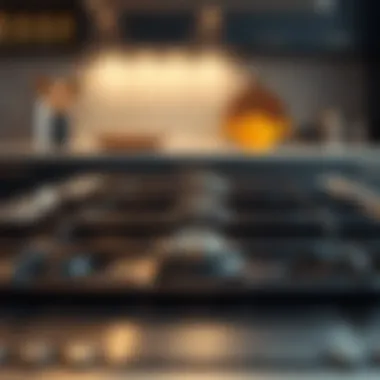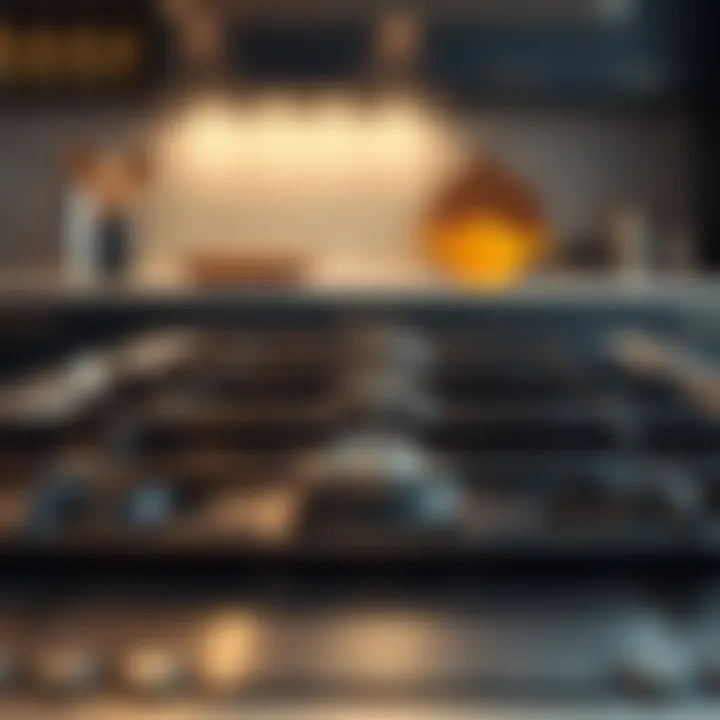Understanding the Roles of Stove Tops and Ovens


Intro
In the world of cooking, the stove top and oven serve as cornerstones of culinary practice. Both appliances have evolved significantly over the years and hold distinct roles in the kitchen. As we dive into their respective functions, it’s vital to understand how they can complement each other to enhance your cooking experience. From the humble beginnings of open flames to the sleek designs we see today, these appliances reflect our culinary advancements.
Wielding power in their own right, stove tops allow for quick adjustments in temperature, perfect for frying, boiling, and sautéing. Ovens, with their steady heat, are invaluable for baking, roasting, and slow-cooking. Each appliance presents its own set of benefits and quirks, influencing both food preparation and the overall dining experience.
Let’s explore the distinctions and harmonies between stove tops and ovens, uncover their historical evolution, and discuss contemporary trends in appliance technology—all to empower homeowners and culinary enthusiasts alike!
Prolusion to Kitchen Appliances
When it comes to cooking, appliances play a pivotal role in shaping our culinary experiences. The kitchen is a lively hub, often teeming with creative energy, where the tools you choose significantly affect the outcome of your dishes. To efficiently navigate culinary practices, one must understand the distinct functions and benefits of various kitchen appliances, primarily stove tops and ovens.
The Importance of Cooking Methods
Cooking is an art, and the method one uses can make all the difference. Each cooking technique — whether it’s boiling, baking, roasting, or sautéing — has its nuances. A stovetop offers the immediacy and control that some dishes demand, like a quick stir-fry or a simmering sauce. Ovens, on the other hand, provide an even, contained heat ideal for baking and browning. Knowing which method to employ for specific dishes can elevate a home-cooked meal from ordinary to exceptional.
Additionally, understanding cooking methods allows for better meal planning. For instance, if you’re looking to prepare a multi-course meal, knowing the capabilities of both your stove top and oven can streamline your efforts. You might roast vegetables while simmering a soup, all the while ensuring that the timing aligns perfectly for a hot and fresh experience.
An Overview of Kitchen Equipment
In the vast world of cooking, kitchen equipment can feel overwhelming. From the humble frying pan to high-tech smart ovens, each piece has a rightful place in the culinary landscape. To get a grip on your kitchen tools, it helps to classify them based on their primary functions. For stove tops, you have electric, gas, and induction types, each offering unique advantages regarding heat management and cooking efficiency. Each type of stove offers its own charm, catering to different needs and preferences.
Ovens, too, come in various models including conventional, convection, and steam ovens, each tailored for specific cooking tasks. Understanding these differences not only helps in selecting the right equipment but also in appreciating how they can work together harmoniously.
To make informed decisions, it’s essential to consider factors such as:
- Installation space: The amount of room available influences the type of stove and oven system suitable for your kitchen.
- Capacity requirements: Do you frequently cook for a large family or just for yourself? Select equipment that meets your regular cooking needs.
- Energy efficiency: Consider appliances that not only serve your cooking needs but also conserve energy and reduce your bills.
By having a solid grasp of kitchen appliances, homeowners and culinary enthusiasts can inspire creativity and confidence in their cooking ventures. It's about harnessing the right tools for the job to create delightful culinary experiences.
Stove Tops: An In-Depth Look
In understanding the landscape of modern kitchens, stove tops play a pivotal role. They are not just appliances; they are an integral part of our culinary experiences. This section dissects the world of stove tops, elucidating their varieties and emphasizing their significance in daily cooking routines.
Stove tops are often what we reach for first. They influence our cooking methods, speed, and even the style of food we create. Choosing the right stove top is just as crucial as stocking the pantry with essential ingredients.
Let's dive into the different types of stove tops available and the characteristics that make them essential.
Types of Stove Tops
Electric Stove Tops
Electric stove tops have become exceedingly popular in households around the globe. One key characteristic of these appliances is their ease of use. Plug them in, and they are ready to shine. They offer consistent heating which is an advantage for novice cooks who may struggle with fluctuating flame intensity. Unlike gas, which can be temperamental, electric systems provide a steady heat, allowing for even cooking.
One unique feature of electric stove tops is the presence of smooth cooktops, made from glass or ceramic. These surfaces not only add a modern flair to kitchens, but they are also easy to clean. However, one must note their tendency to chip or crack, requiring careful handling.
Gas Stove Tops
When it comes to precision and controlling the cooking environment, gas stove tops are like the gold standard. Their key characteristic lies in instantaneous heat. Home cooks and professionals alike appreciate the immediate adjustability of flames, allowing for swift temperature changes. This flexibility proves beneficial when seasoning dishes that require quick gussets of heat.
Gas stove tops also add a unique feature with their open flame, fostering a sense of authenticity in cooking. However, there are concerns here too—higher energy costs and safety issues, especially for households with small children, may lead some to shy away.
Induction Stove Tops
Induction stove tops represent the cutting edge of kitchen technology. Their hallmark feature is electromagnetic heat generation, which only heats the pot or pan, leaving the surrounding area cool to the touch. This specific aspect contributes to exemplary energy efficiency, making them an attractive choice for eco-conscious cooks.
Another highlight of induction cooking is speed; they often heat up faster than both gas and electric options. On the downside, matching cookware is essential. Not all pots and pans will work with induction systems, which can be a drawback for some homeowners looking to keep their existing cookware.
Functional Advantages of Stove Tops


Quick Heating Techniques
Quick heating is one of the clear functional advantages of stove tops, particularly noteworthy when discussing daily cooking. In today’s fast-paced world, having the ability to heat pots and pans in a jiffy cannot be overemphasized.
Electric and induction stove tops stand out here, as both typically offer faster warm-ups compared to traditional gas options. The efficiency of these appliances means less time waiting and more time indulging in meals.
However, while quick heating is certainly beneficial during rush hours or for those in a hurry, it can also lead to overcooking if not monitored closely, presenting a double-edged sword.
Direct Temperature Control
Direct temperature control is another major functional perk of stove tops, allowing cooks to adjust heat without delay. This is where gas stove tops, in particular, shine. The immediate feedback from flame enables a more hands-on approach to cooking, fostering culinary creativity. Whether you need your sauce to simmer or your pan to sear, gas delivers.
Yet, this level of control must come with caution. Less experienced cooks may find themselves with burnt dishes if not careful about the adjustments they make, underscoring the need for close attention.
Maintenance and Care for Stove Tops
Regular Cleaning Practices
Just like any part of the kitchen, stove tops require regular cleaning to maintain optimal performance. Dirty stove tops can lead to inefficient heating and may even affect the taste of the food. Regular cleaning practices should be tailored to the type of stove top.
For instance, electric smooth tops can just need a gentle wipe-down with a soft cloth and specialized cleaner, whereas gas tops may require disassembling burners to get into tight spots.
Overlooking this might not just invite grease buildup; it can turn into a fire hazard over time.
Repairing Common Issues
Knowing how to address common issues that arise with stove tops can save time and money down the road. From scratched surfaces on electric stoves to uneven flames on gas tops, being prepared to tackle these problems can extend the appliance's life substantially.
It's often more feasible to perform minor repairs instead of calling in a professional. However, complex issues, especially those involving gas connections, should always be entrusted to certified technicians for safety.
Innovative Features in Modern Stove Tops
Smart Technology Integration
Smart technology has made its way into kitchen appliances, and stove tops are no exception. This age of technology means users can now control their cooking from a smartphone or manage settings from a smart display.
One beneficial feature is the integration of timers that alert chefs to overcooked pots, enhancing safety and performance. While these are certainly nifty, they may come with higher price tags, which can deter some homeowners.
Energy Efficiency Ratings
Energy efficiency ratings are another essential aspect of modern stove tops, especially for those keen on keeping utility bills low. Many newer models now boast certifications that showcase their power consumption efficiency, which can affirm the long-term savings.
The downside? Older models may not stack up, meaning homeowners might face not just increased costs but also a tougher time transitioning their cooking habits.
In sum, this in-depth look into stove tops sets the stage for understanding their indispensable role in culinary practices. Whether electric, gas, or induction, the insights provided clarify the nuances that affect cooking, efficiency, and maintenance. By examining these aspects, one is better equipped to make educated choices in their kitchen ventures.
Ovens: A Comprehensive Study
Ovens are crucial in every kuitchen not only for their cooking capabilities but also for their ability to define the entire culinary experience. They create a wide range of flavors and textures, whether baking pastries, roasting meaty dishes, or even broiling vegetables. Understanding the various types of ovens available today is essential for making informed cooking equipement choices. Let’s explore their types, functions, maintenance essentials, and current tech trends to see how they can harmonize with stove tops in the kitchen.
Classes of Ovens
Conventional Ovens
Conventional ovens are often the bread and butter of home kitchens. Their simple design makes them highly accessible for both beginners and seasoned chefs alike. One of their key characteristics is the ability to provide steady, even heating, which is perfect for baking and roasting. This consistent heat helps in evenly browning foods and achieving the desired doneness without overly dry spots. A distinctive feature of conventional ovens is the top-and-bottom heating elements; while simple, they can be effective for various cooking tasks. However, they may take longer to preheat compared to their more high-tech counterparts, which can be a drawback when time is of the essence.
Wall Ovens


Wall ovens stand out for their sleek, built-in look and ergonomic advantages. They’re mounted at eye levels, which eliminate the need to bend down to check on your roasted creations. This particular characteristic appeals to many homeowners looking for style and functionality. They often come with additional features like self-cleaning and smart controls. Their unique integration into the kitchen design adds to the aesthetics, providing a seamless look. However, they typically have smaller capacities compared to traditional ranges, which may limit cooking quantities during gatherings.
Convection Ovens
Convection ovens offer a leap in cooking efficiency with their ability to circulate hot air. This feature significantly enhances cooking consistency, reducing baking times and allowing for better browning of foods. Cooks appreciate the versatility of convection ovens, especially when preparing multiple trays of cookies or roasts. Their popularity stems from the advanced technology that many models incorporate, such as adjustable fan speed. However, one must calibrate cooking times and temperatures, as food can cook quicker than in conventional models, which can be a learning curve for some.
Steam Ovens
Steam ovens are a gourmet chef's dream, allowing for gentle cooking that retains moisture and nutrients better than traditional methods. Their main characteristic is the steam injection, which creates soft, succulent dishes while preserving the nutritional value of ingredients. This style is particularly beneficial for health-conscious cooks looking to minimize oil use. Steam ovens can also revive day-old bread or leftovers with a refreshing result. On the down side, these ovens can require a somewhat steeper learning curve and are often perceived as costly options for the average home chef.
Key Functions of Ovens
Baking and Roasting
Baking and roasting are two of the most essential functions of ovens, providing the means to create a range of culinary delights. Baking relies on even heat distribution, allowing breads, cakes, and pies to rise and set correctly. This feature is particularly appreciated for the science involved in transforming raw dough into baked goods. For roasting, ovens provide an excellent environment for meats and vegetables, enabling caramelization and crisping, which enhances flavor. However, both functions require a proper understanding of temperature and timing to achieve the desired results.
Broiling Techniques
Broiling is a technique that transforms the ordinary into extraordinary. It essentially serves as an upper heat source to cook food rapidly, creating a beautiful char on meats and quick-cooking vegetables. This method is perfect for finishing dishes with a crispy texture while preserving juiciness. The key characteristic of broiling is the high heat used, which can be both an advantage and disadvantage; cooking times are short and require constant monitoring to avoid burning. Many cooks gravitate toward broiling for its ability to give dishes a “restaurant feel” at home.
Oven Maintenance Essentials
Self-Cleaning Modes
Self-cleaning modes have dramatically altered the way homeowners approach oven maintenance. This modern feature simplifies the cleaning task by using high temperatures to incinerate food residue, leaving only a bit of ash behind. Crucially, this reduces the need for harsh cleaning chemicals, making it an eco-friendly option. However, it’s important to note that it can be resource-intensive, so users should consider their energy use during this cleaning cycle.
Seasonal Checkups
Just like any other appliance, ovens require seasonal checkups to ensure optimal performance. Regularly scheduled maintenance can prolong an oven's lifespan, ensuring that all components are in working order. This practice could include checking seals, calibrating temperatures, or cleaning out vents. Such preventive measures are far less costly and time-consuming than unexpected repairs or replacements. After all, a working oven means a happy cook!
Trends in Oven Technology
Smart Oven Innovations
In an age where technology reigns, smart oven innovations are at the forefront. These models often come equipped with Wi-Fi connectivity, allowing users to monitor and control their ovens remotely. Key features can include preheating on demand or even functions that notify you when the food is ready. This convenience embodies modern cooking and helps bridge the gap between culinary artistry and day-to-day living. Nevertheless, the reliance on technology can sometimes lead to challenges, such as software updates or connectivity issues.
Energy Consumption Insights
As homeowners become increasingly aware of energy consumption, many modern ovens come with features aimed at efficiency. Understanding the energy insights provided by these newer models can influence purchasing decisions for eco-conscious individuals. Key energy-saving technologies can include better insulation and energy-efficient elements. Yet, the upfront investment for these advanced features may divide opinions on practicality and long-term savings.
The choice of oven is not just about cooking; it’s about creating an environment where culinary creativity can thrive.
Comparative Analysis: Stove Tops vs. Ovens
Understanding the distinctions between stove tops and ovens is more than just a culinary debate; it involves recognizing how these tools of the kitchen complement and influence each other in cooking. This comparative analysis delves into the unique roles of each appliance, discussing factors such as speed and versatility, space design, and cost considerations. By broadening the perspective on how these appliances work together, it allows for wiser decisions when equipping a kitchen, ultimately leading to a more satisfying cooking experience.
Comparing Cooking Capabilities
Speed versus Versatility
When it comes to cooking, speed and versatility can often seem like two sides of the same coin. Stove tops frequently win the speed contest, as they heat up almost instantly. This feature is pivotal for tasks needing immediate heat—like sautéing vegetables or boiling pasta.
However, ovens bring their own kind of versatility to the table, allowing for slow cooking, baking, and roasting. The unique characteristic of an oven is its ability to cook dishes evenly and thoroughly, a crucial element in producing baked goods, such as bread or cakes, where even heat distribution is essential. On the flip side, they require more time to preheat and cook, making them less quick when you are looking for fast results. Therefore, while stove tops might be your go-to for speed, ovens shine with their adaptability to various cooking styles.
Type of Dishes Best Suited


Different dishes cater well to specific cooking methods offered by stove tops and ovens. For instance, stove tops are excellent for making sauces, stews, or any dish that benefits from quick temperature adjustments. The stovetop allows more control over the cooking process, which is essential for certain cuisines that involve rapid cooking processes like stir-frying.
On the contrary, ovens excel with heavy-duty recipes such as casseroles, lasagna, or baked desserts. When you need to achieve that perfect golden-brown crust, an oven is invaluable. This specialized capability makes ovens indispensable for many traditional meals. Ultimately, knowing which appliance suits the dish at hand can elevate the quality of your cooking.
Space and Design Considerations
Kitchen Layout Implications
The layout of a kitchen plays a significant role in appliance selection. In smaller kitchens, a stove top might take precedence due to its compact nature and ability to fit into tight spaces. Conversely, larger kitchens often hold both, allowing for an optimal workflow. The arrangement, however, shouldn't just consider size; accessibility is crucial as well.
Incorporating a stove and oven in an ergonomically sound way can enhance the efficiency of meal preparation. Placing these appliances in proximity to prep areas can streamline the cooking process, making it not just a task, but an enjoyable experience. Moreover, any potential space constraints may affect the overall design aesthetics of the kitchen.
Integrated versus Stand-Alone Units
When deciding between integrated and stand-alone stove tops and ovens, it’s important to think about both functionality and style. Integrated units seamlessly blend with cabinetry, creating a polished, cohesive look, which can maximize space and aesthetics for those who prioritize design. However, they tend to be less flexible; if kitchen needs change, these appliances might not easily adapt.
On the other hand, stand-alone units, while less sleek, are often easier to replace or relocate. They allow for more personalized setups based on individual cooking habits. The choice hinges largely on personal preferences: will you sacrifice classic elegance for a functional adaptability?
Cost-Effectiveness and Investment
Initial Purchase Costs
When it comes to finances, the conversation is often about what you’re willing to invest upfront. Generally, a standard oven and stove can vary greatly in price based on brand, features, and even energy sources. Electric and induction stove tops often carry higher initial costs compared to their gas counterparts; however, gas ovens can be pricier than electric models after factoring installation and ventilation.
Regardless, these initial costs should balance with long-term needs and usage. Picking a high-quality appliance can also yield better performance and longer lifespan, turning out a wise financial decision in the grand scheme.
Long-Term Operating Costs
Long-term costs factor into the full picture of ownership. Ovens that consume more energy or require more frequent repairs can quickly drain finances, while models designed for energy efficiency can save money over time. Similarly, stove tops that utilize gas or electric mechanisms come with different long-term variables.
In the end, delving into energy consumption insights can illuminate what you might face after purchase. Understanding the costs connected directly to usage ensures that the decision to acquire either appliance fits not just culinary needs but also economic stability.
A wise investment now can lead to greater savings and satisfaction in the long run.
By comparing stove tops and ovens through these lenses, we gain insight into how to harmonize our kitchen practices efficiently. Each tool holds its weight, and knowing their strengths ensures culinary success.
The End: Harmonizing Stove Tops and Ovens
When talking about culinary practices, it’s a bit like discussing two sides of the same coin—stove tops and ovens serve unique yet intertwined roles in any kitchen. Understanding how to harmonize their attributes can significantly elevate both cooking efficiency and outcomes. This article emphasizes the necessity of not choosing one over the other, but integrating both into a seamless workflow.
Optimizing Kitchen Workflow
The kitchen is a bustling hub of activity, and the design and placement of stove tops and ovens can make or break the cooking experience. An effective kitchen layout often involves a strategic placement of these appliances, ensuring they complement each other rather than compete for attention. For chefs—be they professionals or home culinary enthusiasts—this is crucial.
- Proximity Matters: Ideally, having the stove top and oven in close range allows for smooth transitions between tasks. Imagine stirring a pot while eyeing the roast in the oven; it’s all about ready access.
- Zoning for Efficiency: Consider implementing zones in your kitchen—one for prep, another for cooking, and another for finishing. Place the stove top near the prep zone and the oven closer to the finishing area. It’s like crafting a cooking flow, maximizing your efficiency and minimizing time spent wandering.
- Maximize Surface Area: Utilize countertops around these appliances to their fullest. When the stove tops are busy, side areas can become makeshift staging zones where dishes can be assembled before the finish in the oven.
By adopting such strategies, culinary tasks become not just feasible but enjoyable, showcasing how stove tops and ovens can work together in harmony.
Final Thoughts on Culinary Equipment Choices
Navigating the culinary landscape means making informed choices about equipment, and understanding the relationship between stove tops and ovens is paramount. Both are indispensable tools that, when chosen wisely, create an effective and versatile cooking environment.
- Assess Your Cooking Style: Reflect on what you cook most often. If you’re a baker at heart, an advanced oven will be your best friend. If frying or sautéing is your jam, a high-performance stove top should take precedence.
- Think Ahead: Consider future needs as well. Family size, dietary preferences, or any budding culinary ambitions. An oven with versatile functions may serve you better if you foresee grander cooking practices.
- Read Reviews and Do Research: There’s no substitute for firsthand experiences. Delve into reviews on sites like reddit.com or home appliance forums. It’s often the little features that make a huge difference in your cooking routine.
Ultimately, it comes down to creating a kitchen that reflects your needs and lifestyle. By understanding and utilizing the strengths of both stove tops and ovens, you can not only improve your cooking efficiency but also enrich your culinary artistry.
"A kitchen is a place of magic, a dance of flavors and techniques, where the harmony of your chosen appliances plays a melody on the palate."
Link for more insights: Kitchen Design Tips
Learn more about specific appliances at Wikipedia
Keep abreast of new kitchen innovations through Facebook Kitchen Page.
By thoughtfully harmonizing the roles of your stove tops and ovens, you navigate not just a space, but an experience that is uniquely yours.







